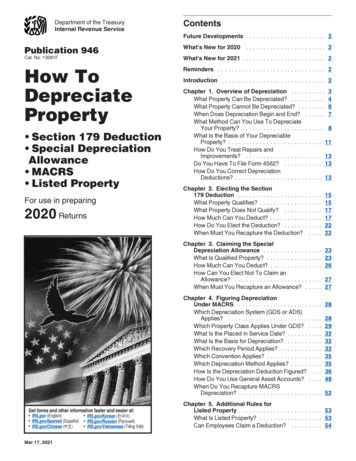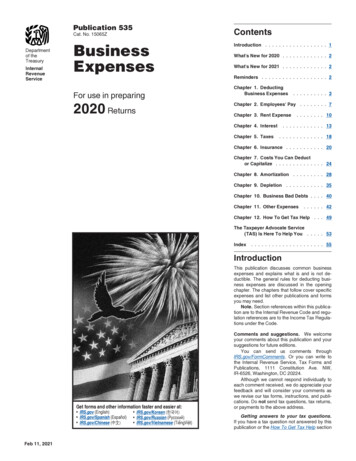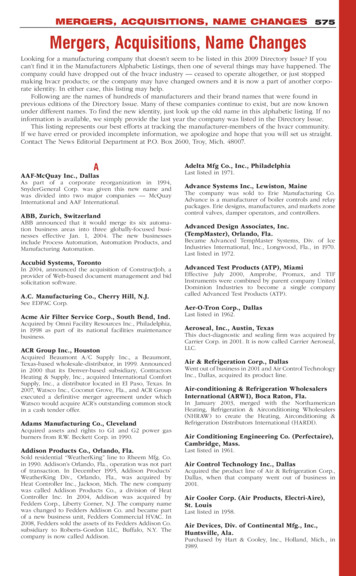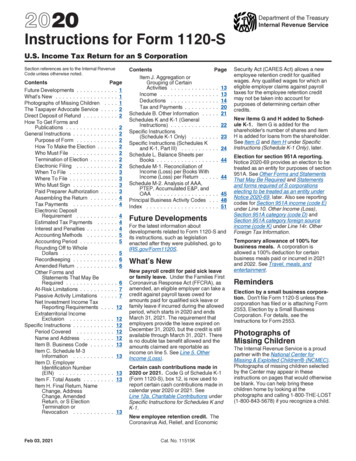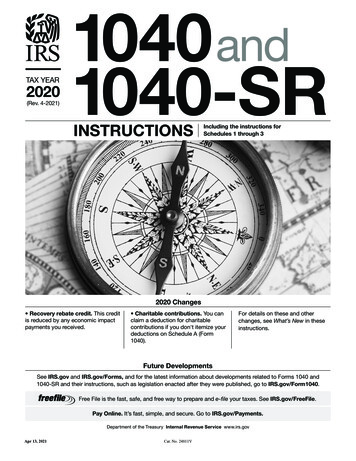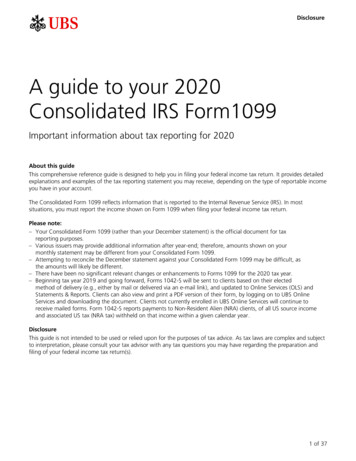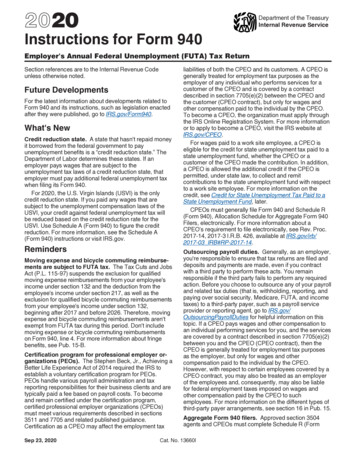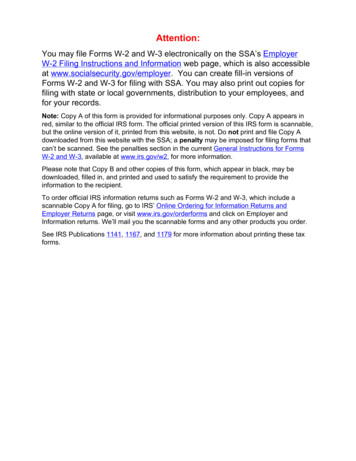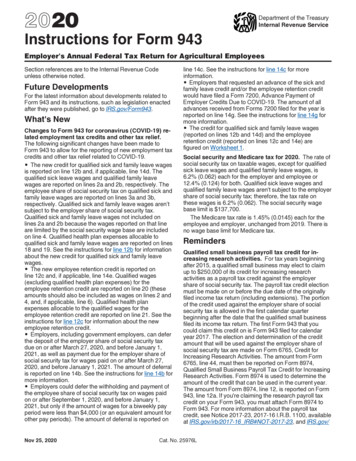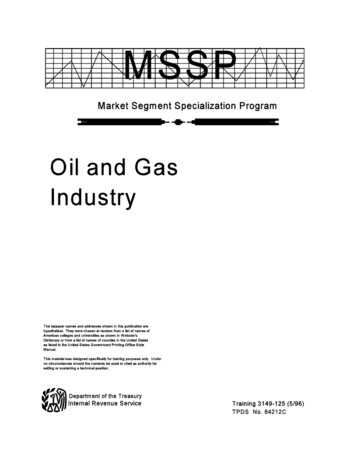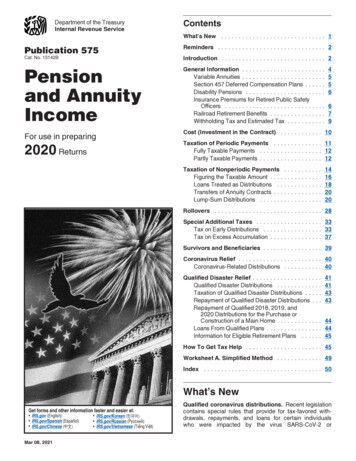
Transcription
Department of the TreasuryInternal Revenue ServicePublication 575ContentsWhat’s New . . . . . . . . . . . . . . . . . . . . . . . . . . . . . . 1Reminders . . . . . . . . . . . . . . . . . . . . . . . . . . . . . . . 2Cat. No. 15142BIntroduction . . . . . . . . . . . . . . . . . . . . . . . . . . . . . . 2Pensionand AnnuityIncomeGeneral Information . . . . . . . . . . . . . . . . . . . .Variable Annuities . . . . . . . . . . . . . . . . . . . .Section 457 Deferred Compensation Plans . .Disability Pensions . . . . . . . . . . . . . . . . . . .Insurance Premiums for Retired Public SafetyOfficers . . . . . . . . . . . . . . . . . . . . . . . . .Railroad Retirement Benefits . . . . . . . . . . . .Withholding Tax and Estimated Tax . . . . . . .For use in preparingCost (Investment in the Contract) . . . . . . . . . . . . 102020 Returns.4556. 6. 7. 9Taxation of Periodic Payments . . . . . . . . . . . . . . 11Fully Taxable Payments . . . . . . . . . . . . . . . . . . 12Partly Taxable Payments . . . . . . . . . . . . . . . . . . 12Taxation of Nonperiodic PaymentsFiguring the Taxable Amount . . . .Loans Treated as Distributions . .Transfers of Annuity Contracts . . .Lump-Sum Distributions . . . . . . .1416182020Rollovers . . . . . . . . . . . . . . . . . . . . . . . . . . . . . . . 28Special Additional Taxes . . . . . . . . . . . . . . . . . . . 33Tax on Early Distributions . . . . . . . . . . . . . . . . . 33Tax on Excess Accumulation . . . . . . . . . . . . . . . 37Survivors and Beneficiaries . . . . . . . . . . . . . . . . . 39Coronavirus Relief . . . . . . . . . . . . . . . . . . . . . . . . 40Coronavirus-Related Distributions . . . . . . . . . . . 40Qualified Disaster Relief . . . . . . . . . . . . . . . . .Qualified Disaster Distributions . . . . . . . . . .Taxation of Qualified Disaster Distributions . .Repayment of Qualified Disaster DistributionsRepayment of Qualified 2018, 2019, and2020 Distributions for the Purchase orConstruction of a Main Home . . . . . . . . .Loans From Qualified Plans . . . . . . . . . . . . .Information for Eligible Retirement Plans . . .41414343. . . 44. . . 44. . . 45How To Get Tax Help . . . . . . . . . . . . . . . . . . . . . . 45Worksheet A. Simplified Method . . . . . . . . . . . . . 49Index . . . . . . . . . . . . . . . . . . . . . . . . . . . . . . . . . . 50What’s NewGet forms and other information faster and easier at: IRS.gov (English) IRS.gov/Spanish (Español) IRS.gov/Chinese (中文)Mar 08, 2021 IRS.gov/Korean (한국어) IRS.gov/Russian (Pусский) IRS.gov/Vietnamese (Tiếng Việt)Qualified coronavirus distributions. Recent legislationcontains special rules that provide for tax-favored withdrawals, repayments, and loans for certain individualswho were impacted by the virus SARS-CoV-2 or
coronavirus disease 2019 (referred to collectively in thispublication as coronavirus) in 2020. See Coronavirus-related distributions, later.Disaster tax relief. Recent legislation contains specialrules that provide for tax-favored withdrawals, repayments, and loans from certain retirement plans for taxpayers who suffered economic losses as a result of certainmajor disasters that occurred in 2020 (other than coronavirus-related distributions). See Qualified Disaster Relieffor information on these special rules, later.Qualified birth or adoption distribution. Beginning intax years after 2019, you can take a distribution from aneligible retirement plan, other than a defined benefit plan,without it being subject to the 10% additional tax for earlydistributions if that distribution is for a qualified birth oradoption. For more information, see Qualified birth oradoption distributions under Exceptions, later.Required minimum distributions (RMDs). For taxyears beginning after 2019, the age for the required beginning date for mandatory distributions is changed for taxpayers reaching age 701/2 after December 31, 2019, toage 72. For more information on these benefits and whenthey are available, see Pub. 590-B, Distributions from Individual Retirement Arrangements (IRAs).RemindersFuture developments. For the latest information aboutdevelopments related to Pub. 575, such as legislationenacted after it was published, go to IRS.gov/Pub575.Disaster tax relief. Special rules provide for tax-favoredwithdrawals and repayments to certain retirement plans(including IRAs) for taxpayers who suffered economic losses as a result of certain major disasters that occurred in2018 and 2019. Special rules also provide for tax-favoredwithdrawals and repayments from certain retirement plans(including IRAs) for taxpayers who suffered economic losses as a result of Hurricane Harvey or Tropical Storm Harvey, Hurricane Irma, Hurricane Maria, or the 2017 California wildfires.Disaster tax relief is also available for taxpayers whosuffered economic losses as a result of disasters declaredby the President under section 401 of the Robert T. Stafford Disaster Relief and Emergency Assistance Act duringcalendar 2016. See Qualified Disaster Relief for information on these special rules.Net investment income tax. For purposes of the net investment income tax (NIIT), net investment incomedoesn't include distributions from a qualified retirementplan (for example, 401(a), 403(a), 403(b), 408, 408A, or457(b) plans). However, these distributions are taken intoaccount when determining the modified adjusted gross income threshold. Distributions from a nonqualified retirement plan are included in net investment income. SeeForm 8960, Net Investment Income Tax—Individuals, Estates, and Trusts, and its instructions for more information.Qualified public safety employees and early distributions. For tax years beginning after 2015, the definition ofqualified public safety employees has been expanded.Page 2Also, the exception for early distributions for public safetyemployees is expanded to include distributions from defined contribution plans. See Qualified public safety employees and Additional exceptions for qualified retirementplans for more information.Photographs of missing children. The IRS is a proudpartner with the National Center for Missing & ExploitedChildren (NCMEC). Photographs of missing children selected by the Center may appear in this publication on pages that would otherwise be blank. You can help bringthese children home by looking at the photographs andcalling 1-800-THE-LOST (1-800-843-5678) if you recognize a child.IntroductionThis publication discusses the tax treatment of distributions you receive from pension and annuity plans and alsoshows you how to report the income on your federal income tax return. How these distributions are taxed depends on whether they are periodic payments (amountsreceived as an annuity) that are paid at regular intervalsover several years or nonperiodic payments (amounts notreceived as an annuity).What is covered in this publication? This publicationcontains information that you need to understand the following topics. How to figure the tax-free part of periodic paymentsunder a pension or annuity plan, including using asimple worksheet for payments under a qualified plan. How to figure the tax-free part of nonperiodic pay-ments from qualified and nonqualified plans, and howto use the optional methods to figure the tax onlump-sum distributions from pension, stock bonus,and profit-sharing plans. How to roll over certain distributions from a retirementplan into another retirement plan or IRA. How to report disability payments, and how beneficiaries and survivors of employees and retirees must report benefits paid to them. How to report railroad retirement benefits. When additional taxes on certain distributions may apply (including the tax on early distributions and the taxon excess accumulation).For additional information on how to report pen-TIP sion or annuity payments on your federal incometax return, be sure to review the instructions onthe back of Copies B, C, and 2 of the Form 1099-R, Distributions From Pensions, Annuities, Retirement orProfit-Sharing Plans, IRAs, Insurance Contracts, etc. thatyou received and the Instructions for Forms 1040 and1040-SR, lines 5a and 5b, and the Instructions for Form1040-NR, lines 5a and 5b.Publication 575 (2020)
A “corrected” Form 1099-R replaces the corresponding original Form 1099-R if the originalCAUTION Form 1099-R contained an error. Make sure youuse the amounts shown on the corrected Form 1099-Rwhen reporting information on your tax return.!What isn't covered in this publication? The followingtopics aren't discussed in this publication.The General Rule. This is the method generally usedto determine the tax treatment of pension and annuity income from nonqualified plans (including commercial annuities). For a qualified plan, you can’t generally use theGeneral Rule unless your annuity starting date is beforeNovember 19, 1996. Although this publication will helpyou determine whether you can use the General Rule, itwon't help you use it to determine the tax treatment ofyour pension or annuity income. For that and other information on the General Rule, see Pub. 939, General Rulefor Pensions and Annuities.Individual retirement arrangements (IRAs). Information on the tax treatment of amounts you receive froman IRA is in Pub. 590-B.Civil service retirement benefits. If you are retiredfrom the federal government (regular, phased, or disabilityretirement) or are the survivor or beneficiary of a federalemployee or retiree who died, see Pub. 721, Tax Guide toU.S. Civil Service Retirement Benefits. Pub. 721 coversthe tax treatment of federal retirement benefits, primarilythose paid under the Civil Service Retirement System(CSRS) or the Federal Employees' Retirement System(FERS). It also covers benefits paid from the Thrift Savings Plan (TSP).Social security and equivalent tier 1 railroad retirement benefits. For information about the tax treatment ofthese benefits, see Pub. 915, Social Security and Equivalent Railroad Retirement Benefits. However, this publication (575) covers the tax treatment of the non-social security equivalent benefit portion of tier 1 railroad retirementbenefits, tier 2 benefits, vested dual benefits, and supplemental annuity benefits paid by the U.S. Railroad Retirement Board.Revenue Service, Tax Forms and Publications, 1111 Constitution Ave. NW, IR-6526, Washington, DC 20224.Although we can’t respond individually to each comment received, we do appreciate your feedback and willconsider your comments and suggestions as we reviseour tax forms, instructions, and publications. Do not sendtax questions, tax returns, or payments to the above address.Getting answers to your tax questions. If you havea tax question not answered by this publication or the HowTo Get Tax Help section at the end of this publication, goto the IRS Interactive Tax Assistant page at IRS.gov/Help/ITA where you can find topics by using the searchfeature or viewing the categories listed.Getting tax forms, instructions, and publications.Visit IRS.gov/Forms to download current and prior yearforms, instructions, and publications.Ordering tax forms, instructions, and publications.Go to IRS.gov/OrderForms to order current forms, instructions, and publications; call 800-829-3676 to order prioryear forms and instructions. The IRS will process your order for forms and publications as soon as possible. Do notresubmit requests you’ve already sent us. You can getforms and publications faster online.Useful ItemsYou may want to see:Publication524 Credit for the Elderly or the Disabled524525 Taxable and Nontaxable Income525560 Retirement Plans for Small Business (SEP,SIMPLE, and Qualified Plans)560571 Tax-Sheltered Annuity Plans (403(b) Plans) ForEmployees of Public Schools and CertainTax-Exempt Organizations571590-A Contributions to Individual RetirementArrangements (IRAs)590-A590-B Distributions from Individual RetirementArrangements (IRAs)590-BTax-sheltered annuity plans (403(b) plans). If youwork for a public school or certain tax-exempt organizations, you may be eligible to participate in a 403(b) retirement plan offered by your employer. Although this publication covers the treatment of benefits under 403(b) plansand discusses in-plan Roth rollovers from 403(b) plans todesignated Roth accounts, it doesn't cover other tax provisions that apply to these plans. For that and other information on 403(b) plans, see Pub. 571, Tax-Sheltered AnnuityPlans (403(b) Plans) For Employees of Public Schoolsand Certain Tax-Exempt Organizations.Comments and suggestions. We welcome your comments about this publication and suggestions for futureeditions.You can send us comments through IRS.gov/FormComments. Or, you can write to the InternalPublication 575 (2020)721 Tax Guide to U.S. Civil Service RetirementBenefits721907 Tax Highlights for Persons With Disabilities907915 Social Security and Equivalent RailroadRetirement Benefits915939 General Rule for Pensions and Annuities939976 Disaster Relief976Form (and Instructions)W-4P Withholding Certificate for Pension or AnnuityPaymentsW-4P1099-R Distributions From Pensions, Annuities,Retirement or Profit-Sharing Plans, IRAs,Insurance Contracts, etc.1099-RPage 3
4972 Tax on Lump-Sum Distributions49725329 Additional Taxes on Qualified Plans (IncludingIRAs) and Other Tax-Favored Accounts53298915-A Qualified 2016 Disaster Retirement PlanDistributions and Repayments8915-A8915-B Qualified 2017 Disaster Retirement PlanDistributions and Repayments8915-B8915-C Qualified 2018 Disaster Retirement PlanDistributions and RepaymentsYou should check with your plan administrator to determine if your plan will accept designated Roth contributions.Tax-sheltered annuity plan. A tax-sheltered annuityplan (often referred to as a 403(b) plan or a tax-deferredannuity plan) is a retirement plan for employees of publicschools and certain tax-exempt organizations. Generally,a tax-sheltered annuity plan provides retirement benefitsby purchasing annuity contracts for its participants.8915-C8915-D Qualified 2019 Disaster Retirement PlanDistributions and Repayments8915-D8915-E Qualified 2020 Disaster Retirement PlanDistributions and Repayments (Use forCoronavirus-Related and Other Qualified 2020Disaster Distributions)8915-ESee How To Get Tax Help near the end of this publicationfor information about getting publications and forms.General InformationDefinitions. Some of the terms used in this publicationare defined in the following paragraphs.Pension. A pension is generally a series of definitelydeterminable payments made to you after you retire fromwork. Pension payments are made regularly and arebased on such factors as years of service and prior compensation.Annuity. An annuity is a series of payments under acontract made at regular intervals over a period of morethan 1 full year. They can be either fixed (under which youreceive a definite amount) or variable (not fixed). You canbuy the contract alone or with the help of your employer.Qualified employee plan. A qualified employee planis an employer's stock bonus, pension, or profit-sharingplan that is for the exclusive benefit of employees or theirbeneficiaries and that meets Internal Revenue Code requirements. It qualifies for special tax benefits, such as taxdeferral for employer contributions and capital gain treatment or the 10-year tax option for lump-sum distributions(if participants qualify). To determine whether your plan isa qualified plan, check with your employer or the plan administrator.Qualified employee annuity. A qualified employeeannuity is a retirement annuity purchased by an employerfor an employee under a plan that meets Internal RevenueCode requirements.Designated Roth account. A designated Roth account is a separate account created under a qualifiedRoth contribution program to which participants may electto have part or all of their elective deferrals to a 401(k),403(b), or 457(b) plan designated as Roth contributions.Elective deferrals that are designated as Roth contributions are included in your income. However, qualified distributions (explained later) aren't included in your income.Page 4Types of pensions and annuities. Pensions and annuities include the following types.Fixed-period annuities.You receive definiteamounts at regular intervals for a specified length of time.Annuities for a single life. You receive definiteamounts at regular intervals for life. The payments end atdeath.Joint and survivor annuities. The first annuitant receives a definite amount at regular intervals for life. Afterhe or she dies, a second annuitant receives a definiteamount at regular intervals for life. The amount paid to thesecond annuitant may or may not differ from the amountpaid to the first annuitant.Variable annuities. You receive payments that mayvary in amount for a specified length of time or for life. Theamounts you receive may depend upon such variables asprofits earned by the pension or annuity funds, cost-of-living indexes, or earnings from a mutual fund.Disability pensions. You receive disability paymentsbecause you retired on disability and haven't reachedminimum retirement age.More than one program. You may receive employeeplan benefits from more than one program under a singletrust or plan of your employer. If you participate in morethan one program, you may have to treat each as a separate pension or annuity contract, depending upon thefacts in each case. Also, you may be considered to havereceived more than one pension or annuity. Your formeremployer or the plan administrator should be able to tellyou if you have more than one contract.Example. Your employer set up a noncontributoryprofit-sharing plan for its employees. The plan providesthat the amount held in the account of each participant willbe paid when that participant retires. Your employer alsoset up a contributory defined benefit pension plan for itsemployees providing for the payment of a lifetime pensionto each participant after retirement.The amount of any distribution from the profit-sharingplan depends on the contributions (including allocated forfeitures) made for the participant and the earnings fromthose contributions. Under the pension plan, however, aformula determines the amount of the pension benefits.The amount of contributions is the amount necessary toprovide that pension.Publication 575 (2020)
Each plan is a separate program and a separate contract. If you get benefits from these plans, you must account for each separately, even though the benefits fromboth may be included in the same check.!CAUTIONDistributions from a designated Roth account aretreated separately from other distributions fromthe plan.Qualified domestic relations order (QDRO). A QDROis a judgment, decree, or order relating to payment of childsupport, alimony, or marital property rights to a spouse,former spouse, child, or other dependent of a participantin a retirement plan. The QDRO must contain certain specific information, such as the name and last known mailingaddress of the participant and each alternate payee, andthe amount or percentage of the participant's benefits tobe paid to each alternate payee. A QDRO may not awardan amount or form of benefit that isn't available under theplan.A spouse or former spouse who receives part of thebenefits from a retirement plan under a QDRO reports thepayments received as if he or she were a plan participant.The spouse or former spouse is allocated a share of theparticipant's cost (investment in the contract) equal to thecost times a fraction. The numerator of the fraction is thepresent value of the benefits payable to the spouse or former spouse. The denominator is the present value of allbenefits payable to the participant.A distribution that is paid to a child or other dependentunder a QDRO is taxed to the plan participant.Variable AnnuitiesThe tax rules in this publication apply both to annuitiesthat provide fixed payments and
2020
